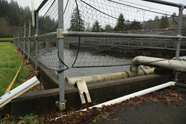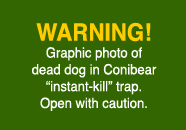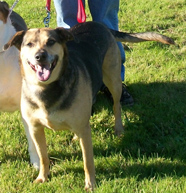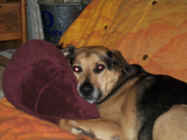Fritz' Heartbreaking and Brutal Death
Couple's beloved Australian Shepherd mix killed in government trap, improperly set 30 feet from public path
On January 20, 2013, a routine Sunday afternoon outing with the family dog turned tragic and deadly for an Oregon couple. Their trip to the fish hatchery hiking path started out like so many they'd enjoyed for over eight years, but ended in horror and shock when the jaws of a Conibear "instant-kill" trap silently slammed shut on the neck of their beloved dog, Fritz.
The family could have been spared tremendous grief and loss, and Fritz could have been spared an untimely and brutal death, if the trap had been set according to established directives.
But these directives are routinely ignored by the federal trappers involved—part of the USDA Wildlife Services' lethal predator control program.
Sadly, this case is no exception.
Fritz' Horrifying Death
Below is the heartbreaking story of Fritz death, as shared by his humans, John Beere and Cindy Corder.
CINDY: John decided to stay home and watch the end of the game that Sunday instead of going for a hike. So Fritz and I headed out to the nearby Salmon River Fish Hatchery where we'd taken him since he was a puppy over 8 years ago. This was our favorite spot because there was no posted sign about leash requirements. Fritz never wandered from me, being a herding breed, but he did like to mark his favorite spots along the path.
When I turned on the blinker he showed his enthusiasm by climbing on the center console, excited to be there. I parked in our usual spot in the designated parking area, placed his leash around my shoulders, grabbed my phone and off we went, same as any other day there. As usual, Fritz went only so far ahead of me before stopping and waiting for me to catch up.
Part way down the path I spotted a crumpled sign sticking 2 feet out of the ground on a skinny broken branch stuck in a gopher hole. I went to get closer to read it and Fritz went ahead.
JOHN: Maybe 20 minutes into the game I got a call. Cindy was in a panic, something about warning signs, traps and Fritz not answering her calls. Fritz always responded when called. I knew something was wrong. I hung up and called the sheriff to find out from animal control about these traps. I was informed they don’t set traps.
A soon as I hung up Cindy called again. She was so hysterical she was hard to understand, but I did make out that Fritz was dead. My heart sank so low I thought my legs were going to give out. This could not be happening.
CINDY: I called Fritz as loudly as I could, walking back and forth trying to find or hear him. Nothing but silence. I found the phone and frantically called John when the hatchery employee appeared and helped me. He found my beloved Fritz dead on the ground, in the grip of a horrid metal trap. He was lying just over a small hump just past the sign—that’s why I could not see him and why he could not come to me. Just feet away from me he had suffered and died in deadly silence. It took two vice grips to get Fritz out of the traps' death grip.
I could not stand it. I didn’t know I could be so mad and so sad at the same time.
This was my dog! He had taken his first breath in my hands. I kicked, screamed, cried and howled, the pain was more than I could bear.
JOHN: When I got to the hatchery I could see Cindy kneeling down across the field. Fritz was lying in front of her and Cindy was crying and telling Fritz how sorry she was over and over. I could see the tools used to free Fritz from the trap lying on the ground.
I was choked up and began yelling, trying to get some answers about signs. People walk their dogs here and kids play here all the time. Why were there no warning signs?
I saw no signs coming into the Hatchery, no signs along the path. There is a public parking area with a wooden sign on a wooden signpost saying 'no vehicles beyond this point'. There should have been a warning sign right there. Cindy would have not gone any further.
The only sign was now under Cindy’s knee. I could see where it had been 'posted'—stuck into a gopher hole maybe 30 feet off the path, and the trap had been set not more than that from the sign.
The hatchery employee would not let us have the sign, saying it was illegal to take it. He was the one to free Fritz and he and his wife were very sympathetic. He offered to bury him. I agreed and showed him where we would like him to be. Down at the far end of the Field where there was a loop trail that Fritz loved.
I went back to the car to get the blanket Fritz always sat on when in the car and
Wrapped it around him. We went home without our dog. Nothing has been the same since. This is so wrong. Part of us died with our boy Fritz.
On Tuesday there was a message on our machine from a man at Wildlife Services in Portland. I called him thinking he was going to help. He said he was only calling to say sorry for our loss. I kept telling him what happened and asking why there was no warning. He said something about a leash. I could not get any answers or information.
I also received an Email from Brooks Fahy of Predator Defense with a phone number and called. I wish I had talked to him first.
THIS SHOULD NEVER HAVE HAPPENED! HE DID NOT DESERVE IT!!!!!
Fritz was an 8 year old, 65 pound Australian Shepherd mix who loved everybody. We had him since the day he was born. He was absolutely the best dog I’ve ever had. I keep looking behind me expecting him to be there.
Wildlife Management Agencies Set Low Standards of Husbandry and Stewardship, Putting Children, Pets, and Wildlife at Risk
The sad and unnecessary loss of a beloved companion animal like Fritz is only part of the story of what goes on at hatcheries, as well as other public and private locations, when wildlife management agencies attempt to address damage to property and farmed animals.

The Salmon Rivery Hatchery pools
clearly show a lack of adequate
fencing or barriers.
A river otter, the
predator they were trying to catch,
could easily access the ponds, as
could a child, dog or cat.
The pictures of the Salmon River Hatchery pools clearly show a lack of adequate fencing (or other barriers) to protect the fish from predators of any kind. A child, dog, cat or any number of wildlife species can easily access the ponds. A decent fencing or alternate barrier system and some strategically placed hot wires would readily protect the ponds and, more importantly, preclude the need for any kind of lethal control methods which pose a serious threat to wildlife, domestic animals and especially small children.
It is particularly disturbing and telling that this and other hatcheries are operated by the Oregon Department of Fish and Wildlife (ODFW), the state agency charged with protecting Oregon's wildlife. Clearly they are blind to standards of good animal husbandry which is the best, first and foremost means of protecting farmed animals, in this case hatchery fish. Rather than taking basic steps to preclude entry to the ponds by providing and maintaining adequate fencing, ODFW instead prefers to immediately use lethal control in the form of deadly traps. This shows not only poor judgement but a direct conflict of interest and a blind adherence to a mindset that routinely choses lethal control first rather than as a last resort. It is more than frightening to know this is the agency the public turns to for information, education on wildlife, how to protect farmed animals from wildlife damage and how to address damage if/when necessary.
Every legislative session the ODFW is allocated funds to contract federal trappers from the USDA Wildlife Services lethal control program. Last biennium a minimum of $840,000 was given to ODFW and ODA (Oregon Dept. of Agriculture) to kill predators, including the river otters targeted by the Salmon River Hatchery. The instant kill trap that crushed the life from Fritz's body in a matter of seconds was set by a federal trapper hired by the state. A child could have been injured, maimed or even killed by such a trap. The most recent statistics available (from 2011), show that four river otters were reported killed by WS traps in Oregon. Two were killed intentionally; the other two were killed by accident.
How many other dogs, cats, other creatures suffered and died in steel straps set to protect fish or other farmed animals because the 'professionals' in charge were too lazy or ignorant to bother to use decent husbandry to protect the animals in their charge?
Government Agents Slide through Loopholes Bigger than Neck Snares in State and Federal Trapping Regulations
Oregon's trapping regulations are extremely liberal. They conveniently allow the Oregon Department of Fish and Wildlife (ODFW) to selectively opt out of recently established public safety restrictions. Trapping guidelines for federal agents, which are clearly spelled out by specific Wildlife Services (WS) directives, are routinely ignored and violated by federal trappers nationwide. The few cases that we learn about where dogs have been injured or killed in traps (and there are many incidents of this occurring in Oregon and nationwide) illustrate and demonstrate a lack of concern for public safety and pets, as well as a clear government bias favoring a minority of trappers at the expense of the general public.
In the last year a startling number of reports have appeared in the media about dogs injured and/or killed in body-gripping traps across Oregon. In response to the clear public safety threat, a petition was launched by a coalition of organizations to reform Oregon trapping laws to include trapping setbacks from publicly frequented areas and trails, and to require posting of warning signs.
The ODFW and their boss, the Oregon Fish and Wildlife Commission, denied the recommendations and instead agreed to watered-down changes from which ODFW could be exempted (see the Oregon Furbearer Trapping and Hunting Regulations, 2012-14). One of the recommendations the Commission rejected was posting warning signs to alert people to the presence/danger of traps set in the immediate area. Although the Commission agreed to establish restrictions on how close traps can be set to trails, ODFW is allowed to be exempt from these restrictions. The state also adopted a regulation that specifically allows land sets of instant-kill traps within 50 feet of a waterway. These are the type of trap that killed Fritz (story above), a border collie named Maggie, and another dog named Kieri.
In addition to the changes referenced above, the Oregon Furbearer Regulations adopted in July 2012 include something new called a "Trapper's Code of Ethics." Not only does this title seem to be an oxymoron (how can one commit an act of brutality and violence in an ethical manner?), but state and federal agents routinely violate many of the ethics, such as the first one listed:
- 1. Set traps only in appropriate locations. Avoid setting traps near high public use areas such as hiking trails, campgrounds, or parks.
But the state's ridiculous definitions of hiking trails, campgrounds, parks, and other public use areas create the loopholes they need to keep the trappers happy and the public in danger.
How Many Beloved Dogs Would Still Be Alive Today if Agents Followed the Rules?
Had the government followed their own regulations and directives, or adopted recommended changes to protect public safety, we would not have to memorialize the deaths and near deaths of the wonderful companion animals on our website.
Fritz the Australian shepherd mix would still be alive today if the state had agreed to a signage requirement and abided by it. Fritz would still be alive today had the state not exempted itself from kill trap restrictions. Fritz would still be alive today had WS followed its own internal guidelines for warning signs and followed state restrictions on land sets of kill traps, as their guidelines indicate they are supposed to do.
Maggie the border collie would still be alive today had WS notified the public as required by their directives, and obeyed their own rule and state law regarding conibear land sets.
Bella the Husky mix would still have all her legs if WS had posted warning signs as required by their directives.
And another dog named Kieri would still be alive today had ODFW complied with state laws regarding kill traps. A fourteen year old child, under direct supervision of an ODFW employee, set the conibear trap that killed Kieri.
But these are just a few cases out of countless. The reality is that this is a nationwide epidemic. For in-depth information, please read the following:
- "Sacramento Bee" expose on Wildlife Services - in-depth features, editorials, and followup articles calling for a Congressional investigation and agency reform
- List of documented "non-target victims" of Wildlife Services, 1990-2011
How You Can Help
Please help us stop tragedies like Fritz' death by contacting your favorite news show or your local media. Give them a link to this story and ask them to do an investigative expose on this case and the USDA's barbaric, wasteful and indiscriminate Wildlife Services program. If you can help us spread the word by making a financial contribution, donate today. Any amount helps.
**************************************
About Conibear Traps

Wildlife Services (WS) spends about
$126 million tax dollars a year killing
wildlife. In addition to the known
victims,
thousands of pet dogs and cats
presumed missing by their owners are
likely killed by WS traps
and poisons.
Photo courtesy of Project
Coyote
The Conibear "instant-kill" trap kills by breaking the neck and strangling the victim. It is square, with two rotating jaws. The larger version has two springs and is almost impossible to open by hand. You can see an animal-eye view of the Conibear trap by watching this video.
Conibear traps are used to capture and instantly kill species—such as badger, beaver, bobcat, coyote, fisher, lynx, nutria, otter, and raccoon—but they are indiscriminate. This means that pets, endangered species, and other non-target animals, such as Fritz (above), can also become trapped in their jaws.
According to the manufacturer’s website, Oneidavictor.com, these traps “should NOT, however, be used where non-target animals are at risk for capture” (original text in bold). The traps are strong enough to maim, injure, and kill a child.


